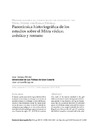Please use this identifier to cite or link to this item:
https://accedacris.ulpgc.es/handle/10553/42359
| Title: | Panorámica historiográfica de los estudios sobre el Mitra védico, avéstico y romano | Other Titles: | Historiographical overview on the studies of the Vedic, Avestic and Roman Mithras | Authors: | Campos Méndez, Israel | UNESCO Clasification: | 550401 Historia antigua | Keywords: | Mitra Mitraísmo Avesta Veda Cumont, et al |
Issue Date: | 2018 | Publisher: | 1885-2718 | Journal: | Revista de Historiografia | Abstract: | El interés que ha suscitado la figura del dios Mitra ha dejado como reflejo estudios que se remontan al periodo romano. Sin embargo, a partir del Renacimiento el descubrimiento casual de piezas escultóricas de asunto mitraico, atrajo el interés de investigadores que indagaron en sus escritos sobre la identidad de la divinidad que aparecía matando un toro. Durante los siglos XVI al XVIII, la temática solar y la identificación del Mitraísmo se convirtió en el contenido de estos estudios. A partir del s. XIX, empieza a tomar forma una investigación de carácter más científico sobre la cuestión mitraica, que encontrará su nacimiento formal con los trabajos de F. Cumont a principios del s. XX. Este siglo pasado ha sido el que ha visto florecer el mayor y más profundo volumen de estudios desentrañando los misterios vinculados al dios Mitra, tanto en su vertiente de divinidad de los panteones védicos y avésticos, como en el ámbito del culto mistérico desarrollado en el marco del Imperio Romano. En los comienzos del siglo XXI, todavía permanecen abiertas algunas hipótesis iniciales, pero sí se constata una vitalidad en los estudios para la comprensión global del Mitraísmo. One mark of the interest attached to the god Mithra is the line of studies dating back to the Roman period. It was, however, during the Renaissance that the accidental discovery of sculptural pieces of a Mithraic subject attracted the interest of researchers, who sought to identify the bull-killing divinity. Between the 16th and 18th centuries, this field of research re-oriented itself to the solar theme and the identification of Mithraism. In the 19th century, it took on a scientific nature, and the landmark the studies of F. Cumont saw the light of day in early 20th century. As the century progressed ambitious in-depth studies flourished, unravelling the mysteries linked to the cult of the god Mithra, both in terms of the divinity of the Vedic and Avestan pantheons and of the sphere of the mystery cult established in the context of the Roman Empire. At the beginning of the 21st century, some initial hypotheses remain open, but the vitality of studies pursuing a global understanding of Mithraism remains unchallenged. |
URI: | https://accedacris.ulpgc.es/handle/10553/42359 | ISSN: | 1885-2718 | DOI: | 10.20318/revhisto.2018.4302 | Source: | Revista de Historiografía [ISSN 1885-2718], v. 29, p. 297-311 |
| Appears in Collections: | Artículos |
SCOPUSTM
Citations
2
checked on Jun 8, 2025
Page view(s)
174
checked on Jan 4, 2025
Download(s)
212
checked on Jan 4, 2025
Google ScholarTM
Check
Altmetric
Share
Export metadata
Items in accedaCRIS are protected by copyright, with all rights reserved, unless otherwise indicated.
